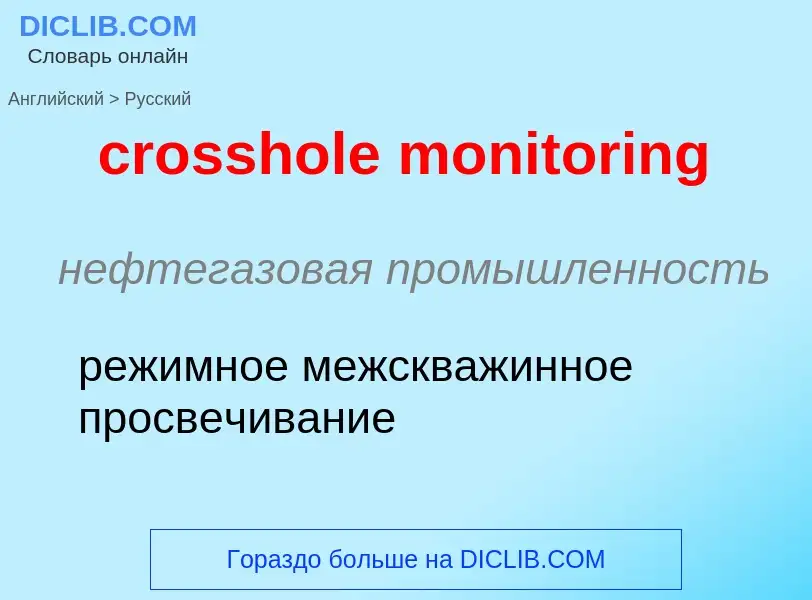Übersetzung und Analyse von Wörtern durch künstliche Intelligenz ChatGPT
Auf dieser Seite erhalten Sie eine detaillierte Analyse eines Wortes oder einer Phrase mithilfe der besten heute verfügbaren Technologie der künstlichen Intelligenz:
- wie das Wort verwendet wird
- Häufigkeit der Nutzung
- es wird häufiger in mündlicher oder schriftlicher Rede verwendet
- Wortübersetzungsoptionen
- Anwendungsbeispiele (mehrere Phrasen mit Übersetzung)
- Etymologie
crosshole monitoring - Übersetzung nach russisch
нефтегазовая промышленность
режимное межскважинное просвечивание
['mɔnit(ə)riŋ]
общая лексика
регистрация функций организма с сигнализацией об отклонениях от нормы
мониторинг
перманентный контроль
слежение (напр. за состоянием среды)
дозиметрический контроль
дозировка
слежение, контроль, мониторинг
контролирование
контролирующий
контроль
контроль подслушиванием
контрольно-выпрямительный
контрольный
коррекция гироскопа
подслушивание
проверка
управление
управляющий
медицина
дозиметрия
мониторное наблюдение
наблюдение
мониторирование
регулирование
строительное дело
контроль, мониторинг (непрерывное наблюдение переменной)
дистанционный диспетчерский контроль
нефтегазовая промышленность
текущий контроль
Смотрите также
существительное
общая лексика
контроль
подслушивание
радиоперехват
физика
дозировка
дозиметрический контроль
Definition
Wikipedia
Crosshole sonic logging (CSL) is a method to determine the structural integrity of drilled shafts and other concrete piles.
The CSL method is considered to be more accurate than sonic echo testing in the determination of structural soundness of concrete within the drilled shaft inside of the rebar cage. This method provides little indication of concrete soundness outside the cage.
Also known as Crosshole Acoustical Testing, CSL normally requires steel (preferred) or PVC access tubes installed in the drilled shaft and tied to the rebar cage. Before the rebar cage is placed in the hole, the CSL access tubes are attached to the interior of the rebar cage. The cage is then lowered into the hole and the concrete is placed. Steel CSL tubes are preferred over PVC tubes because studies have shown that PVC tubes tend to debond from the concrete due to the heat of hydration process of concrete, resulting in erratic CSL test results.
The tubes are filled with water as an intermediate medium. After curing for 3–7 days, a sound source and receiver are lowered, maintaining a consistent elevation between source and sensor. A signal generator generates a sonic pulse from the emitter which is recorded by the sensor. Relative energy, waveform and differential time are recorded, and logged. This procedure is repeated at regular intervals throughout the pile and then mapped. Areas of signal loss or wave speed reduction greater than 10 percent represent potential physical anomalies and can be targeted for further exploration. Measurements of relative energy or amplitude loss can be indicative of poor curing conditions or concrete heterogeneity including improper mixing of admixtures or retention of concrete laitance within the drilled shaft. By comparing the graphs from the various combinations of access tubes, a qualitative idea of the structural soundness of the concrete throughout the pile can be gleaned.
A more advanced, higher-end analysis that creates a mock 3-dimensional graphical display of the concrete soundness throughout the pile is known as Crosshole Sonic Tomography.

